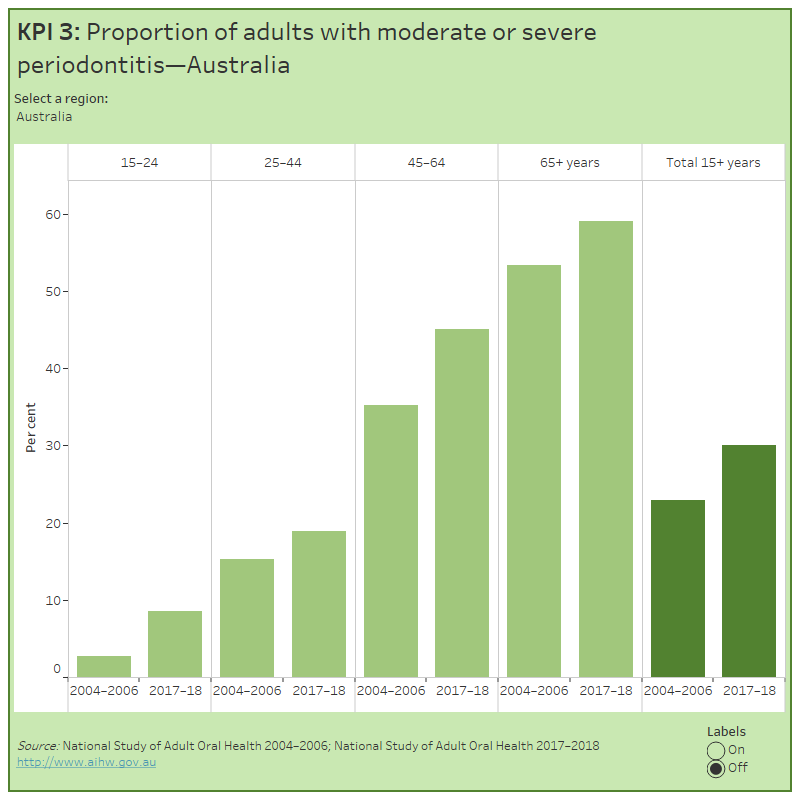Periodontitis prevalence
KPI 3: Proportion of adults with moderate or severe periodontitis
Periodontitis, or advanced stage gum disease, damages the soft tissue and bone supporting the teeth which can cause the teeth to become loose, which in turn can lead to tooth loss.
In 2017–18, around one-third (30%) of adults aged 15 years and over had moderate or severe periodontitis, an increase from around one-quarter (23%) in 2004–06.
In 2017–18, the proportion of adults with periodontitis increased with age from 8.6% in those aged 15–24 to 59% in those aged 65 years and over.
KPI 3: Proportion of adults with moderate or severe periodontitis—Australia
This figure shows the proportion of adults aged 15 years and over with moderate or severe periodontitis. National, state and territory data is presented for 2004-06 and 2017-18. In Australia, 30% of adults aged 15 years and over had moderate or severe periodontitis in 2017-18.

Data tables available for download.
More information about periodontitis.
KPI 3 Periodontitis prevalence
For KPI 3 three relevant data sources (NSAOH, NDTIS and public dental services) have been identified. Separate definition tables and data capturing rules have been provided for each data source identified.
|
Definition |
Proportion of adults with moderate or severe periodontitis Total number of individuals (aged 15+ years) examined in the reporting period with a moderate or severe periodontitis Denominator |
|
Desirable rate |
Low |
|
Data sources |
NSAOH |
|
Inclusions |
Age group Sites Moderate or severe periodontitis(1) |
|
Exclusions |
Edentulous individuals |
| Definition |
Proportion of adults with moderate or severe periodontitis Numerator Denominator |
|
Desirable rate |
Low |
|
Data sources |
NDTIS |
|
Inclusions |
Age group Survey response (NDTIS) - Overall, how would you rate the health of your teeth and gums? - Have you ever had treatment for gum disease such as scaling and root planning, sometimes called 'deep cleaning'? - Have you ever had any teeth become loose on their own, without an injury? - During the last three months, have you noticed a tooth that doesn’t look right? |
|
Exclusions |
Edentulous individuals |
Definition |
Proportion of adults with moderate or severe periodontitis Numerator Denominator |
|||||||
|
Desirable rate |
Low |
|||||||
|
Data sources |
Public dental |
|||||||
|
Inclusions |
Age group Sites(3) (under CPI)
The two molars in each posterior sextant are paired for recording, and if one is missing, there is no replacement. If no index teeth or tooth is present in a sextant qualifying for examination, all the remaining teeth in that sextant are examined and the highest score is recorded as the score for the sextant. In this case, distal surfaces of third molars should not be scored. Coding(3) (under CPI) Moderate or severe periodontitis |
|||||||
|
Exclusions |
Edentulous Individuals |
- From definition developed jointly by the US Centers for Disease Control and Prevention (CDC) and the American Academy of Periodontology (AAP) adopted for NSAOH.
- Slade GD. Interim analysis of validity of periodontitis screening questions in the Australian population. J Periodontol 2007;78:1463-1470.
- Adapted from World Health Organisation (WHO) Oral health surveys – basic methods, 4th edition, 1997.


